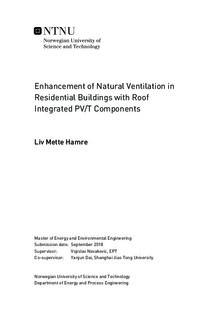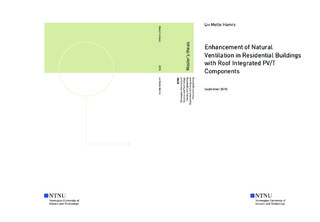| dc.description.abstract | The purpose of this master thesis was to develop a design method for a combined system comprising
of an air type photovoltaic thermal system and natural ventilation for the case of a typical residential
building. The prototype and model to be simulated had different air flows. The prototype available
had a serpentine shape of the air flow, and needed a forced flow to function. Larger deviations
between experimental measurements and simulation output were therefore accepted. The model
was first developed for forced flow, and then advanced to encompass natural flow.
Several software programs were considered for the task. After some software obstacles, TRNSYS in
combination with Matlab was chosen due to the flexibility. The PV/T component and the natural
ventilation effect was programmed in Matlab. The weather file, heat transfer coefficient and the
building were constructed in or uploaded to TRNSYS. The simulation was performed by running
the Matlab script in TRNSYS for each time step for the interval set in TRNSYS.
Several design settings were tested for increased performance. The optimal solution was achieved by
applying the maximum area for maximum electrical production. Increased length of panel resulted in
a heightened stack effect and higher air flow. A longer system will also increase outlet temperature,
which is preferred in winter time. For raised outlet temperature, a small channel height was also
found to be favoured. An increase in the channel height will enhance the natural ventilation flow.
With a constant channel height, 0.5 m was the optimal height. With a seasonal optimised channel
height, the time the natural ventilation satisfied the requirements, increased with 8%. 20 degrees
inclination angle proved to be the best solution for this system. In a climate like Shanghai, natural
ventilation is optimal in transition seasons. In summer the ambient air is usually too warm and
humid. Increased ambient temperature led to a lower buoyancy effect, and therefore a lower air
flow. During winter the ambient air can be too cold. | |

